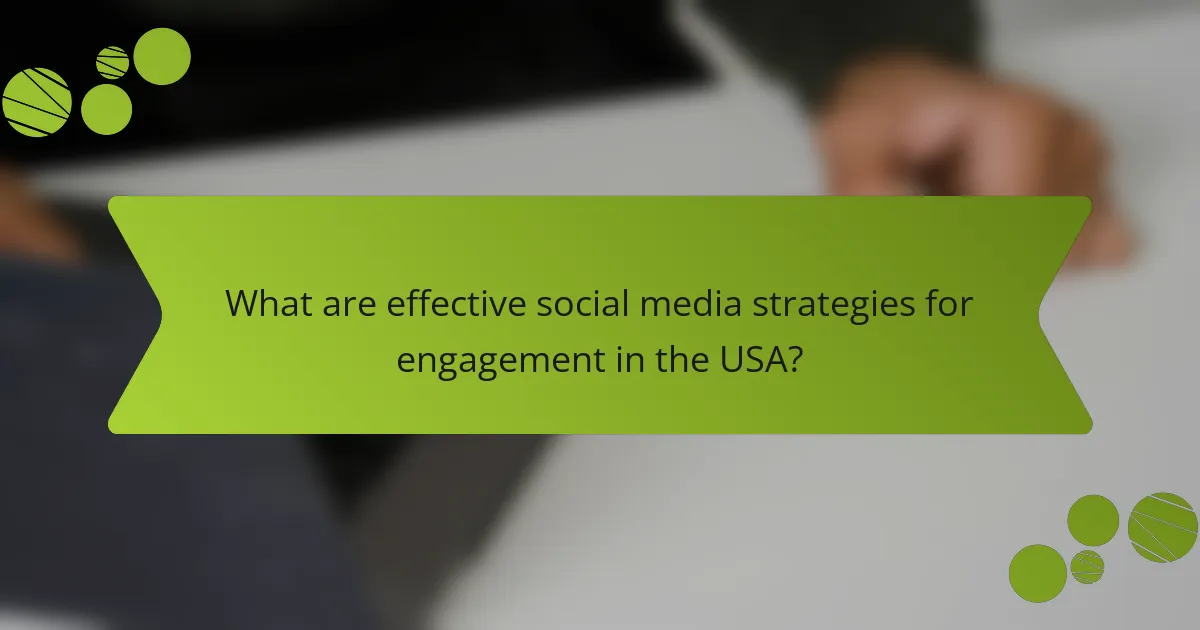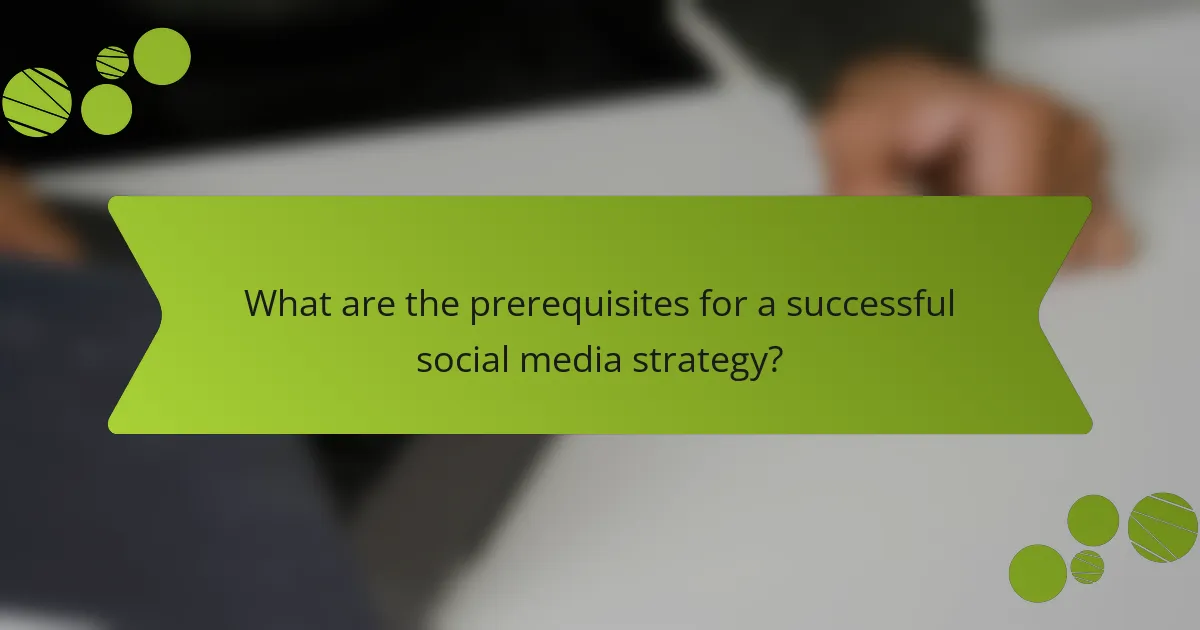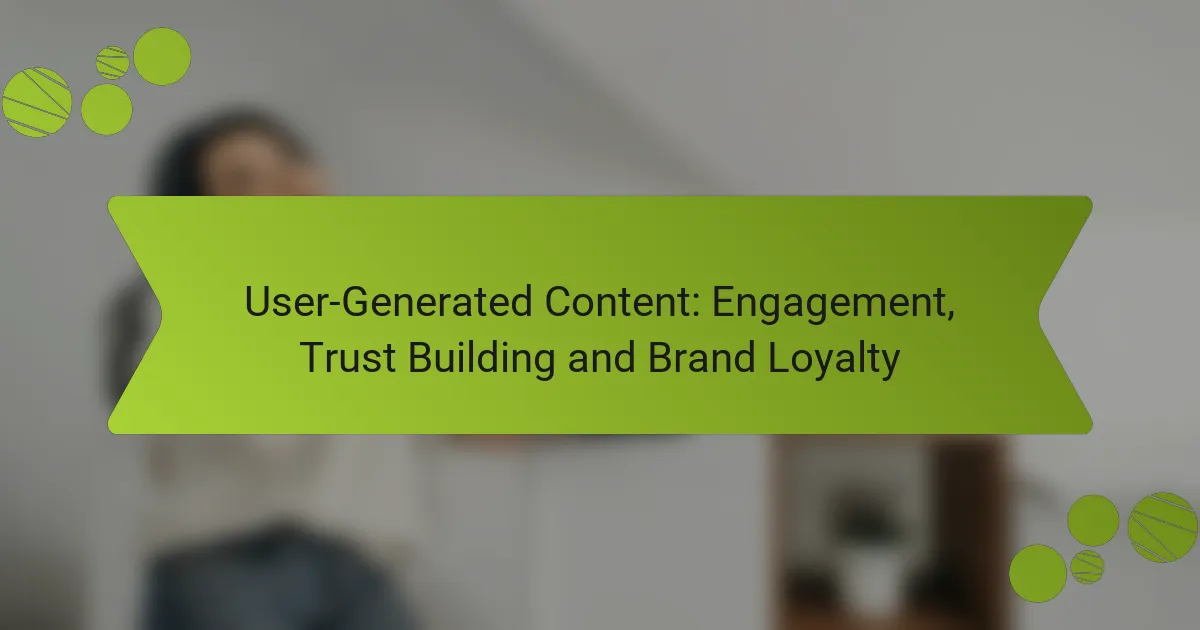In today’s digital landscape, effective social media strategies are essential for enhancing user engagement and driving sales growth. By focusing on personalized and interactive experiences, businesses can foster community and strengthen connections with their audience. Leveraging targeted advertising and tracking key metrics allows companies to convert engagement into tangible results, ensuring continuous improvement and success in their social media efforts.

What are effective social media strategies for engagement in the USA?
Effective social media strategies for engagement in the USA focus on creating personalized, interactive, and authentic experiences for users. These methods enhance user interaction, foster community, and ultimately drive sales growth.
Content personalization
Content personalization involves tailoring social media posts to meet the specific interests and preferences of your audience. By analyzing user data, brands can create targeted messages that resonate more deeply with followers, increasing engagement rates.
Consider using tools that segment your audience based on demographics, behaviors, or past interactions. Personalized content can include customized recommendations, localized promotions, or even addressing users by name in comments and messages.
Utilizing user-generated content
User-generated content (UGC) refers to any content created by your customers, such as reviews, photos, or videos featuring your products. Leveraging UGC can enhance authenticity and trust, as potential customers often find peer-generated content more relatable than brand messaging.
Encourage your audience to share their experiences with your products by hosting contests or featuring their content on your official pages. This not only boosts engagement but also creates a sense of community among your followers.
Leveraging live video
Live video is a powerful tool for real-time engagement, allowing brands to connect with their audience instantly. It can be used for product launches, Q&A sessions, or behind-the-scenes looks, fostering a more personal connection with viewers.
To maximize impact, promote your live sessions in advance and encourage viewer participation through comments and questions. This interaction can significantly enhance viewer retention and engagement during the broadcast.
Engaging with influencers
Collaborating with influencers can amplify your brand’s reach and credibility. Influencers have established trust with their followers, making their endorsements more impactful than traditional advertising.
Select influencers whose values align with your brand and whose audience matches your target demographic. This ensures that your message resonates well and leads to higher engagement and conversion rates.
Running interactive polls
Interactive polls are an effective way to engage your audience and gather valuable insights. They encourage participation and can be used to gauge opinions on products, services, or trends relevant to your brand.
Utilize features available on platforms like Instagram and Twitter to create quick polls. Keep questions simple and relevant to maintain user interest, and share the results to foster further discussion and engagement.

How can businesses boost sales through social media?
Businesses can boost sales through social media by leveraging targeted advertising, promotions, shoppable posts, and retargeting strategies. These techniques help reach potential customers effectively and convert engagement into sales.
Targeted advertising campaigns
Targeted advertising campaigns allow businesses to reach specific demographics based on interests, behaviors, and location. Platforms like Facebook and Instagram offer robust tools for creating ads that can be tailored to various audience segments.
To maximize effectiveness, define clear objectives for your campaigns, such as increasing website traffic or generating leads. Monitor performance metrics regularly to adjust your strategy and ensure optimal results.
Promotions and discounts
Offering promotions and discounts through social media can significantly increase sales by attracting new customers and encouraging repeat purchases. Limited-time offers or exclusive discounts for followers can create urgency and drive immediate action.
Consider using eye-catching visuals and clear calls-to-action in your posts to highlight these promotions. Ensure that the terms are straightforward to avoid confusion and enhance customer satisfaction.
Creating shoppable posts
Shoppable posts enable businesses to tag products directly in their social media content, allowing users to purchase items without leaving the platform. This seamless shopping experience can lead to higher conversion rates.
Utilize platforms like Instagram and Facebook, which support shoppable features, to showcase your products effectively. Ensure that your product descriptions are clear and engaging to entice potential buyers.
Utilizing retargeting strategies
Retargeting strategies involve displaying ads to users who have previously interacted with your brand but did not complete a purchase. This technique helps keep your products top-of-mind and encourages users to return and finalize their transactions.
Implement retargeting through platforms like Google Ads or Facebook Ads by creating custom audiences based on user behavior. Regularly refresh your ad content to maintain interest and engagement among potential customers.

What metrics should be tracked for social media success?
To achieve social media success, it’s crucial to track metrics that reflect engagement, conversion, follower growth, and website traffic. These metrics provide insights into how well your social media strategies are performing and where adjustments may be needed.
Engagement rates
Engagement rates measure how actively your audience interacts with your content. This includes likes, shares, comments, and overall participation. A high engagement rate indicates that your audience finds your content valuable and relevant.
To calculate engagement rate, divide the total engagement by the total followers and multiply by 100. Aim for engagement rates between 1% to 5% as a general benchmark, but this can vary by industry.
Conversion rates
Conversion rates track the percentage of users who take a desired action after engaging with your social media content, such as making a purchase or signing up for a newsletter. This metric is vital for understanding the effectiveness of your social media campaigns in driving sales or leads.
To improve conversion rates, ensure your calls-to-action are clear and compelling. A conversion rate of 2% to 5% is often considered good, but this can differ based on the platform and industry.
Follower growth
Follower growth indicates how your audience size is changing over time. A steady increase in followers suggests that your content resonates with users and attracts new audiences. Tracking this metric helps assess the effectiveness of your outreach and content strategies.
Monitor follower growth monthly and aim for consistent increases. A growth rate of 5% to 10% per month is a healthy target, but this can vary based on your niche and marketing efforts.
Traffic to website
Traffic to your website from social media channels measures how many users click through to your site from your social posts. This metric is essential for evaluating the effectiveness of your social media in driving potential customers to your offerings.
Use tools like Google Analytics to track this traffic and assess which platforms and posts generate the most visits. Aim for a steady increase in referral traffic, and consider using UTM parameters to better understand the source of your traffic.

What are the prerequisites for a successful social media strategy?
A successful social media strategy requires a clear understanding of your target audience, well-defined objectives, and the selection of appropriate platforms. These elements form the foundation for effective engagement and sales growth through social media channels.
Defining target audience
Identifying your target audience is crucial for tailoring your social media strategy. Consider demographics such as age, gender, location, and interests to create a detailed profile of your ideal customer.
Utilize tools like surveys and social media analytics to gather insights about your audience’s preferences and behaviors. This information will guide your content creation and engagement tactics, ensuring they resonate with the right people.
Setting clear objectives
Establishing clear objectives is essential for measuring the success of your social media efforts. Common goals include increasing brand awareness, boosting engagement, generating leads, or driving sales.
Use the SMART criteria—Specific, Measurable, Achievable, Relevant, and Time-bound—to formulate your objectives. For instance, aim to increase your follower count by a certain percentage within a specific timeframe to track progress effectively.
Choosing the right platforms
Selecting the right social media platforms is vital for reaching your target audience. Each platform has its unique user base and content style; for example, Instagram is ideal for visual content, while LinkedIn is better suited for professional networking.
Evaluate where your audience spends their time and consider the type of content you plan to share. A diverse approach across multiple platforms can enhance your reach, but focus on those that align best with your goals and audience preferences.

How do social media algorithms impact visibility?
Social media algorithms determine how content is prioritized and displayed to users, significantly affecting its visibility. These algorithms analyze user interactions, preferences, and behaviors to curate feeds that maximize engagement.
Understanding algorithm changes
Social media platforms frequently update their algorithms to enhance user experience and engagement. Changes can include shifts in how content is ranked based on likes, shares, comments, and even the time spent on posts. Staying informed about these updates is crucial for maintaining visibility.
For instance, a platform might prioritize video content over static images, requiring brands to adapt their strategies accordingly. Regularly reviewing platform announcements and industry news can help marketers anticipate these changes.
Optimizing content for algorithms
To improve content visibility, focus on creating high-quality, engaging posts that resonate with your target audience. Use relevant hashtags, post at optimal times, and encourage interactions through questions or calls to action. Consistency in posting can also enhance algorithm favorability.
Consider analyzing your audience’s behavior to determine the best times to post and the types of content they engage with most. Tools like social media analytics can provide insights into performance metrics, helping you refine your strategy over time.








